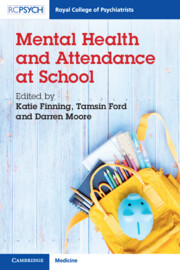Book contents
- Mental Health and Attendance at School
- Mental Health and Attendance at School
- Copyright page
- Contents
- Contributors
- Preface
- Acknowledgements
- Chapter 1 Mental Health and Attendance at School
- Chapter 2 School Attendance
- Chapter 3 Emotional Disorders and Attendance at School
- Chapter 4 Behavioural Disorders and Coping with School
- Chapter 5 Neurodevelopmental Disorders and Attendance at School
- Chapter 6 Educating a ‘New Me’ after an Acquired Brain Injury
- Chapter 7 School Influences on Attendance and Special Educational Needs
- Chapter 8 Supporting the Attendance of Vulnerable Children at School
- Chapter 9 School Attendance and Anxiety
- Chapter 10 Reflections on the Impact of Covid-19 on Children’s Education and Mental Health
- Index
- References
Chapter 3 - Emotional Disorders and Attendance at School
Published online by Cambridge University Press: 24 March 2022
- Mental Health and Attendance at School
- Mental Health and Attendance at School
- Copyright page
- Contents
- Contributors
- Preface
- Acknowledgements
- Chapter 1 Mental Health and Attendance at School
- Chapter 2 School Attendance
- Chapter 3 Emotional Disorders and Attendance at School
- Chapter 4 Behavioural Disorders and Coping with School
- Chapter 5 Neurodevelopmental Disorders and Attendance at School
- Chapter 6 Educating a ‘New Me’ after an Acquired Brain Injury
- Chapter 7 School Influences on Attendance and Special Educational Needs
- Chapter 8 Supporting the Attendance of Vulnerable Children at School
- Chapter 9 School Attendance and Anxiety
- Chapter 10 Reflections on the Impact of Covid-19 on Children’s Education and Mental Health
- Index
- References
Summary
Anxiety and depression (“emotional disorders”) are common mental health conditions in young people. A substantial body of research links emotional disorders with school attendance problems, dating at least as far back as the 1960s when the terms “school phobia” and “school refusal” were used to refer to young people who had difficulty attending due to emotional distress. Recent studies have shown that depression in particular is strongly associated with absenteeism, and that emotional disorders are most predictive of unauthorised absence compared to other types of absence. Emotional disorders may directly lead to absenteeism via symptoms such as insomnia, fatigue or avoidance of anxiety-provoking stimuli in the school environment. A range of other factors may also play a role including comorbidities with other health conditions, bullying, poor teacher–pupil relationships, poor academic attainment, and family adversity. Prevention and intervention serve to reduce the burden of emotional difficulties and improve academic outcomes. Early identification of difficulties and a collaborative team-based approach are recognised as key steps to supporting young people who are experiencing these difficulties, alongside the identification of individual needs, adopting a whole-school approach to mental health, and the provision of more specialised interventions where necessary.
Keywords
- Type
- Chapter
- Information
- Mental Health and Attendance at School , pp. 38 - 58Publisher: Cambridge University PressPrint publication year: 2022



